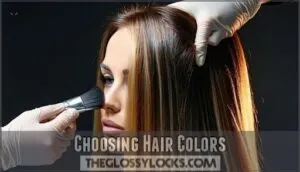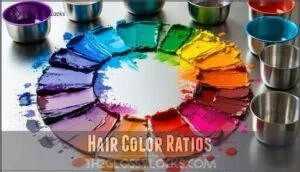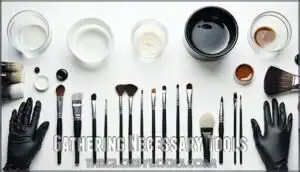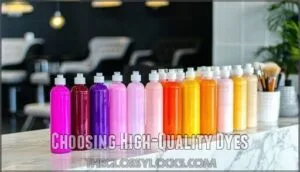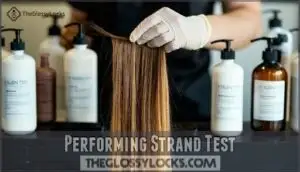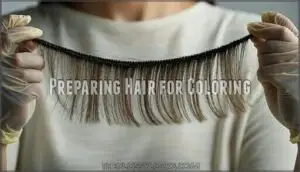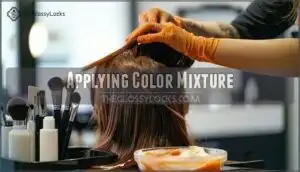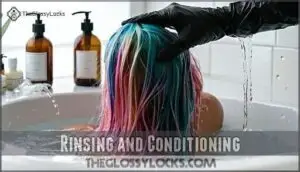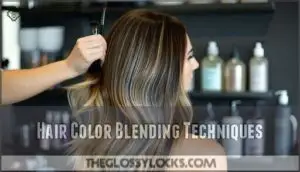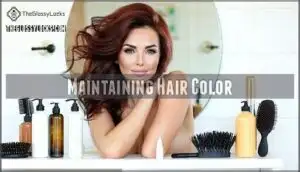This site is supported by our readers. We may earn a commission, at no cost to you, if you purchase through links.
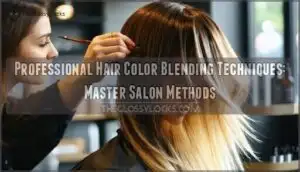
You’ll master balayage for hand-painted highlights, foilyage for controlled dimension, and ombre for gradual shifts.
Start with a strand test to verify color compatibility, then apply using sectioning patterns that follow your hair’s natural growth.
Mix complementary shades at varying ratios – typically 70/30 or 60/40 for subtle blends, or 50/50 for bolder contrasts.
Professional colorists use weaving techniques to distribute highlights evenly while maintaining depth at the roots.
The secret lies in understanding how different dye formulations interact and timing your application to achieve that coveted salon-quality finish.
Table Of Contents
Key Takeaways
- You’ll master three essential techniques—balayage for hand-painted highlights, ombre for gradual color transitions, and foilyage for controlled dimension—each requiring specific sectioning patterns and application methods
- You can’t mix incompatible dye types like semi-permanent with permanent formulas, but you’ll achieve best results using the same brand and performing strand tests to verify color compatibility before full application
- You’ll create professional blends using strategic mixing ratios—70/30 or 60/40 for subtle effects, 50/50 for bolder contrasts—while considering your client’s skin undertones to select complementary colors
- You’ll maintain your color investment through proper rinsing with lukewarm water, using sulfate-free conditioners, and applying color-depositing products between salon visits to prevent fading and extend vibrancy
Hair Color Mixing Basics
Understanding hair color compatibility is essential before you start any mixing process, as different dye types react differently when combined.
Semi-permanent and permanent dyes can’t be mixed due to their distinct formulations, which creates uneven color results and potential chemical reactions that damage both your hair and the final outcome, highlighting the importance of complete concepts and understanding hair color compatibility.
Mixing incompatible dyes creates chemical chaos that damages your hair and ruins your color dreams.
Semi-Permanent and Permanent Dyes
You can’t mix semi-permanent and permanent dyes due to fundamental formula differences that create dye incompatibility.
These chemical reactions produce uneven results, compromised color longevity, and potential hair damage when professional hair dye formulations clash during hair color mixing.
- Semi-permanent dyes lack ammonia and use direct deposit methods
- Permanent hair dye requires alkaline developers to lift cuticles
- Combining incompatible formulas prevents proper pigment absorption and leads to dye incompatibility.
Demi-Permanent and Permanent Dyes
Versatility defines demi-permanent and permanent hair dye compatibility, though you’ll achieve best results using the same brand.
These professional hair dye formulations share similar chemical reactions and developer volume requirements, ensuring reliable color longevity and gray coverage.
Brand compatibility prevents unpredictable outcomes when you’re mastering hair color blending techniques, making demipermanent hair dye an excellent complement to permanent hair dye for dimensional results.
Demi-permanent color is ideal for those seeking subtle color shifts.
Semi-Permanent and Demi-Permanent Dyes
When combining semipermanent hair dye with demipermanent hair dye, you’ll encounter compatibility issues due to their different developer requirements.
Semipermanent formulas don’t require developer, while demipermanent formulas need low-volume developer for proper activation.
This fundamental difference affects color longevity, gray coverage, and shine enhancement. Product selection becomes critical since mixing these formulas creates unpredictable damage levels and inconsistent results in your hair color blending techniques.
Choosing Hair Colors
You’ll need to select colors strategically to achieve professional blending results that complement your client’s features.
Choose a primary base color first, then pick a secondary shade that harmonizes with both the base and your client’s skin tone for natural-looking dimension.
Selecting Primary Color
When choosing your base shade during client consultation, consider the color wheel and your client’s natural undertones to establish the perfect foundation.
Your primary color selection determines the overall result and affects how secondary colors will interact with existing hair condition.
- Assess natural undertones – Warm, cool, or neutral tones guide your base shade selection
- Evaluate hair condition – Porosity and damage levels impact color absorption and mixing ratios
- Reference the color wheel – Understanding complementary colors prevents muddy results in hair color blending
Choosing Secondary Color
Your secondary color creates depth and dimension when carefully selected to complement your base shade.
Choose colors that share similar undertones to avoid muddy results – warm secondaries pair with warm primaries, while cool tones harmonize with cool bases.
Consider complementary colors for subtle contrast or analogous shades for seamless blending.
Your secondary color should enhance dimensional effects while supporting current trend inspiration through strategic color accents that elevate your hair color mixing techniques.
For example, those with warm skin tones might consider honey blonde hues to enhance their complexion, using warm skin tones and strategic color accents to create a desired look with dimensional effects.
Considering Skin Tone
Your skin’s undertones act as your personal color compass, guiding smart hair color choices that enhance rather than clash with your natural palette.
Warm undertones pair beautifully with golden, copper, and honey shades, while cool undertones shine with ash, platinum, and violet-based colors.
Neutral skin offers flexibility with most hues, and during your hair color consultation, you can perform undertone analysis by examining wrist veins and jewelry preferences.
This analysis helps select complementary colors that create stunning, personalized hair color results.
Hair Color Ratios
Achieving the perfect hair color blend requires mastering precise mixing ratios that balance multiple shades seamlessly.
You’ll learn three essential ratio techniques that professional colorists use to create everything from subtle dimension to bold transformations.
Even Ratio Mixing
When you’re mixing hair dyes using equal parts, you’ll achieve perfect color balance and predictable outcomes.
This fundamental mixing technique combines 1/2 of your primary shade with 1/2 of your secondary color, creating consistent results every time.
The dyetodeveloper ratio remains standard while your color formulas blend harmoniously, delivering uniform shade intensity, making it ideal for beginners mastering professional mixing techniques.
Dominant Color Mixing
Creating a dominant color requires strategic Pigment Concentration—you’ll want three-quarters base shade mixed with one-quarter accent color.
Perfect color balance demands the right ratio—three parts dominance, one part accent magic.
This approach guarantees your primary hue maintains control while adding subtle dimension.
Here’s your dominant mixing blueprint:
- Measure 75% primary color for strong Visual Perception impact
- Add 25% secondary shade to enhance Shade Intensity without overwhelming
- Test Color Dominance Effects on hair strand before full application
- Document successful hair color ratios for consistent Ratio Experimentation results
This technique creates sophisticated hair dye mixtures where your chosen base truly shines.
Customizing Color Ratios
Beyond standard formulas, you’ll need to adjust hair color ratios based on specific client needs.
Consider Desired Intensity when creating custom blends – darker hair requires stronger ratios for Coverage Needs.
Tone Adjustment becomes critical when neutralizing unwanted hues.
Experiment with Formulation Tweaks using hair color additives and professional hair color mixing tools.
Visualizing Results helps determine if your hair color formulas need modification before application.
Mixing Hair Color Dyes
Before you start mixing your perfect color blend, you’ll need the right tools and products to achieve professional results.
Start by gathering mixing bowls, applicator brushes, gloves, and clips, then choose high-quality dyes from the same brand to guarantee compatibility and perform a strand test to preview your final shade.
Gathering Necessary Tools
You’ll need specific hair color mixing tools to achieve professional results. Start with non-metallic mixing bowl types like glass or ceramic, which won’t react with chemicals.
Select applicator brush styles with synthetic bristles for even distribution. Don protective gear including gloves and aprons. Use dedicated tools exclusively for coloring to prevent contamination.
A color whisk creates smooth consistency, while a color brush blends seamlessly. Proper tool sanitation between uses maintains quality standards.
Consider using a specialized mixing container for superior results, ensuring you have the right equipment for professional results and a smooth consistency with every application of coloring tools.
Choosing High-Quality Dyes
Professional hair color products make all the difference between amateur results and stunning transformations.
Quality ingredients guarantee vibrant, long-lasting color while protecting your hair’s integrity during the blending process.
Many stylists purchase salon professional dyes for their clients.
- Ingredient Quality – Look for ammonia-free formulas with nourishing oils that minimize damage while maximizing color penetration
- Brand Reputation – Choose established professional brands with consistent performance records and reliable color matching systems
- Color Longevity – Select dyes with fade-resistant technology that maintain vibrancy through multiple washes and styling sessions
- Gray Coverage – Opt for formulas specifically designed for complete gray coverage if working with resistant or coarse hair textures
- Hair Health – Prioritize products containing bond-building additives that strengthen hair during the coloring process
Performing Strand Test
After selecting quality dyes, perform a strand test to preview your color outcome.
Mix a small amount of your formula and apply it to a hidden section of hair. This allows you to assess timing accuracy, check for allergic reactions, and evaluate potential damage.
The strand test reveals how your hair responds to the mixture, enabling formula adjustment before full application.
Professional hair color blending techniques rely on this preliminary step to guarantee successful results and client satisfaction.
Applying Hair Color
Once you’ve perfectly mixed your hair color formula, it’s time to transform your client’s look through precise application techniques.
Professional colorists know that proper sectioning, timing, and placement make the difference between amateur results and salon-quality perfection.
Preparing Hair for Coloring
Evaluating your hair’s condition sets the foundation for successful color application.
Understanding hair porosity, scalp health, and previous treatments helps determine the best approach for your specific hair type and color goals.
- Examine hair porosity – Test strand absorption to predict color uptake
- Check scalp condition – Look for irritation, sensitivity, or recent chemical exposure
- Review treatment history – Document previous colors, relaxers, or damage-causing processes
- Assess current damage – Identify breakage, dryness, or compromised hair integrity
Applying Color Mixture
Section-by-section hair color application methods guarantee professional hair color uniformity through systematic technique.
Start by sectioning hair into manageable quarters using application tools like tail combs and clips.
Apply your mixed formula from roots to ends in half-inch sections, maintaining consistent timing application across all areas.
Work quickly but methodically to prevent uneven processing.
Wear gloves and use barrier cream around hairline for avoiding staining skin and clothes during this vital stage.
Before starting, it’s important to remove product buildup for the best color results to achieve professional hair color uniformity.
Rinsing and Conditioning
Once your processing time ends, proper hair color rinsing and hair color conditioning become your next priorities.
Water temperature affects color retention substantially—lukewarm water prevents fading while hot water strips pigments.
- Rinse Time: Allow 3-5 minutes of thorough water flow to remove excess product completely
- Conditioner Types: Use sulfate-free, color-safe formulas designed for hair color treatments
- Color Sealants: Apply pH-balancing treatments to lock pigments and extend vibrancy
Post-color care with specialized hair color products guarantees your hair color maintenance routine protects your investment long-term.
Hair Color Blending Techniques
Professional hair color blending techniques transform ordinary color services into dimensional masterpieces that clients can’t stop admiring.
You’ll master three essential methods that create seamless shifts and natural-looking results through precise application and expert color placement, which are complete concepts that lead to dimensional masterpieces.
Balayage Technique
You’ll master balayage highlights by painting color freehand onto hair sections, creating natural sun-kissed effects.
This hair color technique requires strategic balayage placement, starting at mid-lengths and sweeping upward.
Proper sectioning methods guarantee even color distribution, while blending techniques create seamless transitions.
Color selection depends on your base shade, and balayage maintenance extends regrowth time substantially.
Ombre Technique
Creating stunning ombre hair color requires mastering vertical blending techniques that seamlessly shift from dark roots to lighter ends.
This gradient effect offers endless ombre variations, from classic brunette-to-blonde to bold reverse ombre styles.
Essential ombre techniques include:
- Color melting technique for smooth shade transitions
- Short ombre applications using precise brush control
- Ombre maintenance through strategic root touch-ups
Professional ombre hair color demands careful sectioning and feathering motions to avoid harsh demarcation lines.
Foilyage Technique
Combining freehand balayage painting with foil wrapping, foilyage delivers brighter highlights while maintaining natural blending techniques.
This dimensional foilyage method uses strategic foil placement to increase lift intensity on darker hair. You’ll hand-paint highlights from mid-lengths to ends, then wrap selected sections in foil for enhanced processing.
Foilyage enhances the lift of lightener, creating brighter ribbons of color.
| Step | Technique |
|---|---|
| Section Selection | Hand-paint highlights using balayage strokes |
| Foil Placement | Wrap painted sections for controlled heat exposure |
| Processing Time | Allow 30-45 minutes for ideal lift intensity |
| Color Development | Monitor foilyage variations throughout process |
| Final Result | Achieve luminous hair highlights with seamless blending |
Maintaining Hair Color
Once you’ve achieved your desired color blend, proper maintenance keeps your professional results looking fresh for weeks longer.
Smart maintenance techniques prevent color fading and extend the life of your custom blend, saving both time and money between salon visits, which is a key part of proper maintenance.
Root Touch-Up
Regular root touch-ups preserve your hair color blending while extending color longevity.
Apply root concealers every four to six weeks using matching roots techniques. Focus on gray coverage areas first, then blend outward using root shadowing methods.
DIY touch-ups work best with demi-permanent formulas.
Professional hair colorists recommend sectioning hair systematically for even application and seamless hair color techniques.
Color Correction
When root touch-ups aren’t enough, hair color correction becomes your solution.
Professional corrective formulas address uneven tints and unwanted results through strategic application methods.
Key correction techniques include:
- Neutralizing undertones with blue-based formulas for orange tones
- Toning techniques using violet agents for yellow-tinged results
- Damage repair protocols with bond-building treatments
- Client consultation to assess previous color history.
Ash toners counteract warmth in 90% of cases, while double-toning enhances retention by 55%.
To maintain vibrancy, clients should use color-safe shampoo.
Using Color-Depositing Products
Some professionals swear by color-depositing products to maintain their masterpiece between salon visits.
You’ll achieve Color Boost and Tone Maintenance using weekly hair gloss treatments that Refresh Highlights while preventing unwanted brassiness.
These toner for hair formulations help Extend Vibrancy and Prevent Fading through gentle pigment deposits.
These products offer convenient color solutions for at-home use.
Strategic application enhances your hair color blending work, supporting professional hair color techniques without harsh chemicals or dramatic color correction needs, which can be considered as Prevent Fading.
Frequently Asked Questions (FAQs)
What is a hair color blending technique?
Transforming your hair color becomes absolutely magical when you master blending techniques.
You’ll seamlessly merge different shades using methods like balayage, ombre, or color melting to create natural-looking gradations without harsh lines, which is a key part of achieving a magical hair color transformation.
What are the advanced hair coloring techniques?
You’ll master balayage hand-painting, foilyage combining foils with freehand techniques.
Color melting is for seamless gradients, ombre creates dramatic shifts.
Babylights mimic natural highlights, and smoky tones blend cool greys and silvers effectively.
How to blend two hair colors together?
Choose colors from the same brand and type. Mix equal parts or adjust ratios for desired dominance. Add developer per instructions, whisk thoroughly, and apply immediately for seamless blending.
Whats the difference between cool and warm undertones?
Cool undertones contain blue, green, or violet bases that create ash, platinum, or icy effects. Warm undertones have yellow, orange, or red bases producing golden, copper, or honey tones.
Can you mix brands of professional hair color safely?
Generally, you shouldn’t mix different hair color brands.
Each brand has unique formulations, and mixing them can cause unpredictable chemical reactions, uneven color results, or processing issues that compromise your professional outcome.
How long should you wait between bleaching sessions?
Like hair needs healing between battles, your strands require patience after bleaching’s chemical assault.
Wait 2-3 weeks minimum between sessions, allowing damaged cuticles to recover and preventing breakage from over-processing your hair.
Conclusion
Surprisingly, the most complex professional hair color blending techniques often produce the most natural-looking results.
You’ve learned that mastering these methods requires understanding color theory, proper mixing ratios, and precise application timing.
Whether you’re creating subtle balayage highlights or bold ombre gradations, success depends on quality products, thorough strand testing, and systematic sectioning patterns.
With consistent practice of these professional hair color blending techniques, you’ll achieve salon-quality results that enhance your natural beauty while maintaining healthy hair integrity.
- https://www.schwarzkopf.com/article-overview/haircolor/all-you-need-to-know-about-foilyage.html
- https://www.joico.com/balayage-vs-foilyage-techniques/
- https://casbahspa.com/the-difference-between-foilyage-vs-balayage/
- https://blog.wella.com/gb/foilyage-ideas-and-techniques
- https://www.allaboutsalon.com.au/foilyage-vs-babylights-what-is-the-perfect-hair-coloring-technique-for-you

